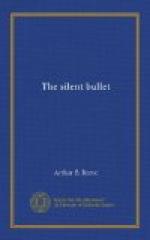“Something over three thousand degrees Centigrade,” replied Poissan, as he and his assistant busied themselves about the furnace.
We sat watching him in silence.
“Ah, gentlemen, now I am ready,” he exclaimed at length, when everything was arranged to his satisfaction. “You see, here is a lump of sugar carbon—pure amorphous carbon: Diamonds, as you know, are composed of pure carbon crystallised under enormous pressure. Now, my theory is that if we can combine an enormous pressure and an enormous heat we can make diamonds artificially. The problem of pressure is the thing, for here in the furnace we have the necessary heat. It occurred to me that when molten cast iron cools it exerts a tremendous pressure. That pressure is what I use.”
“You know, Spencer, solid iron floats on molten iron like solid water—ice—floats on liquid water,” explained Craig to me.
Poissan nodded. “I take this sugar carbon and place it in this soft iron cup. Then I screw on this cap over the cup, so. Now I place this mass of iron scraps in the crucible of the furnace and start the furnace.”
He turned a switch, and long yellowish-blue sheets of flame spurted out from the electrodes on either side. It was weird, gruesome. One could feel the heat of the tremendous electric discharge.
As I looked at the bluish-yellow flames they gradually changed to a beautiful purple, and a sickish sweet odour filled the room. The furnace roared at first, but as the vapors increased it became a better conductor of the electricity, and the roaring ceased.
In almost no time the mass of iron scraps became molten. Suddenly Poissan plunged the cast-iron cup into the seething mass. The cup floated and quickly began to melt. As it did so he waited attentively until the proper moment. Then with a deft motion he seized the whole thing with a long pair of tongs and plunged it into a vat of running water. A huge cloud of steam filled the room.
I felt a drowsy sensation stealing over me as the sickish sweet smell from the furnace increased. Gripping the chair, I roused myself and watched Poissan attentively. He was working rapidly. As the molten mass cooled and solidified he took it out of the water and laid it on an anvil.
Then his assistant began to hammer it with careful, sharp blows, chipping off the outside.
“You see, we have to get down to the core of carbon gently,” he said, as he picked up the little pieces of iron and threw them into a scrap-box. “First rather brittle cast iron, then hard iron, then iron and carbon, then some black diamonds, and in the very centre the diamonds.
“Ah! we are getting to them. Here is a small diamond. See, Mr. Spencer—gently Francois—we shall come to the large ones presently.”
“One moment, Professor Poissan,” interrupted Craig; “let your assistant break them out while I stand over him.”




